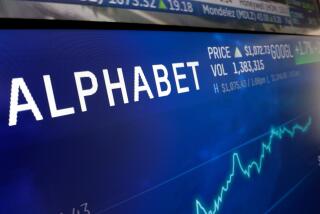Bellwether Intel Reports 25% Jump in Net Income
- Share via
Intel Corp., the world’s biggest computer chip maker, said Tuesday that global demand for chips in notebook computers and mobile phones helped boost its first-quarter profit nearly 25%.
The company, considered a barometer for the health of the technology industry, also gave an optimistic forecast for second-quarter revenue, suggesting that technology spending by consumers and corporations would at least keep pace with personal computer sales worldwide this year. Intel chips run more than 80% of the world’s desktop and notebook computers.
Although desktop computer sales growth has slowed, the market for wireless-enabled laptops -- most of which are powered by Intel’s Centrino chip technology -- is booming, helping the chip maker continue to grow.
Driven by declining laptop prices and the proliferation of wireless access points in public and private spaces, the trend is good news for Intel because profit margins for mobile processors are higher than for comparable desktop products.
“A lot of people are using notebooks instead of desktops,” said David Wu, an analyst in San Francisco with Global Crown Capital. And “other than servers, [laptop chips are] the most profitable thing they make. They’re the market share leader and performance leader.”
In the quarter ended April 2, Santa Clara, Calif.-based Intel earned $2.15 billion, or 34 cents a share, compared with $1.73 billion, or 26 cents, in the first quarter of last year.
Revenue was $9.43 billion, up 16% from $8.09 billion a year earlier.
Analysts surveyed by Thomson First Call had expected a profit of 31 cents a share on revenue of $9.3 billion.
For the second quarter, revenue is expected to be $8.6 billion to $9.2 billion, Intel Chief Financial Officer Andy Bryant said. Analysts expect revenue to be $8.9 billion, up about 11% from the second quarter of last year.
Intel shares gained 42 cents Tuesday to $22.63 on Nasdaq and rose to $23.45 after hours.
Some investors had expressed worries about technology spending this year after IBM Corp. and Samsung Corp. reported profits that fell short of expectations.
“Second-half demand is a concern,” said Apjit Walia, a semiconductor analyst in New York with investment bank RBC Capital Markets. “There are concerns that the overall economy is slowing down.”
But Intel’s Bryant was upbeat about the company’s outlook for the year.
“In general, when we look at the worldwide economy, it looks pretty healthy,” Bryant said in a conference call with financial analysts. “There will be soft spots, but as of today worldwide demand seems pretty solid.”
Although revenue from notebook microprocessors was strong, sales of flash memory, used by devices such as mobile phones and digital cameras to retain data when the devices are turned off, were lower during the quarter. So were sales of chipsets, or the supporting chips and circuitry surrounding processors, and motherboard units.
Intel’s results came 40 years to the day after company co-founder Gordon Moore predicted that the number of transistors that engineers could fit on a chip would double every one or two years.
“We feel we are on firm footing on the strength of our business model,” Bryant said. “The economics of the model are inherent in the unique aspects of silicon technology as predicted by Gordon Moore 40 years ago.”






